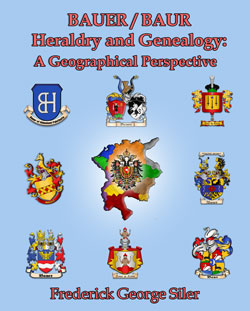
|
|
|
| Product Information: | ||
| Details: | Bauer/Baur Heraldry and Genealogy: A Geographical Perspective; by Frederick George Siler; 2019; 213 pp; 8.5x11; paperback; ISBN: 978-1-62859-253-5; Item #: FR0703. This volume deals with the Germanic heraldry of families whose name was one of the most common in Germany - that of Bauer. The Bauer surname is said to have originated in the Central European cultural and linguistic regions where the Austro-Bavarian dialect of German is spoken. Bauer is a Germanic surname that was established long ago during the Medieval Period. The name is said to have developed from the following two primary sources:
Variations of the Bauer surname Ever since the late middle ages, surnames in every European country have continued to spread out and develop into a significant number of variant spellings. Since the early use of the Bauer surname in southern Germany and Austria, the name and its variants spellings had quickly spread to northern and eastern Switzerland as well as throughout the rest of Europe. In English and other European languages, such as Yiddish and Danish the name is also spelled many ways. For example, Boer, and Boere are variants derived from the Dutch word for "farmer." Likewise, Agricola is the Latin word for farmer. For example, the birth name of famous German scholar and scientist Georgius Agricola (1494–1555) was actually Georg Pawer which is a common variant of Bauer. The Scottish and English surname Bower or Burr (from the Old English bur) are altered spellings of the German family name Bauer. Other variations found in the southern German region of Swabia are Bauerle, Beuerle, and Beyerle.As the Bauer surname has become widespread, not only in Germany, Austria, and eastern Switzerland but throughout Europe, many different spellings of the name have arisen over the centuries. The following variant spellings were investigated during the preparation of this book: Agricola, Baauer, Baehr, Bauaer, Bauar, Bauear, Baueer, Bauer, Bauera, Bauerbach, Bauere, Bauerfeind, Bauerfeindt, Bauerg, Bauerhans, Baueri, Baueria, Bauerie, Bauerii, Bauerjahn, Bauerk, Bauerl, Bauerle, Bauerlein, Bauermann, Bauermeister, Bauermüller, Bauern, Bauernfeind, Bauernfeindt, Bauernfeund, Bauerr, Bauerre, Bauers, Bauert, Bauier, Bauiere, Bauir, Baumeister. Bauor, Baur, Baurer, Baurers, Baurier, Bauyer, Baweer, Bawer, Bawere, Bawier, Baworόw, Bawr, Beuerle, Beyerle, Boer, Boere, Bohr, Bower, Bowra, Bowyer, Burr, Pauer, Paur, Pawer, Pawher and Pawr. German heraldry is unlike British heraldry where a coat-of-arms is associated with one person. Siler's book includes arms that originated as house marks, guild marks, and burgher arms that have been used by families for centuries. Also included are noble armorial bearings that have been granted to the children of an individual and have been passed down through descendants. It should be noted that the volume is heavily footnoted, allowing the researcher to locate and examine the original source materials from which the author drew his information. An amazing place index is found at the rear of the book, allowing genealogists to often associate a specific place with Bauer families. It is the author's belief that there is often a coat of arms that may be associated with one's European ancestor. It may not be that of a direct ancestor or that of one's ancestral family, but it could well be linked, if only by the proximity of geographical location. This one-of-a-kind book is the fourth in a series exploring the heraldry and genealogy of common German surnames with a focus on the English-speaking family historian who seeks another fresh approach to their research. This is not another book about how to trace your German ancestors or a reprint of readily available information from old sources. Most family historians will concede that the research process begins to become more tedious when we attempt to deal with European historical locations and records written in a foreign language. Armed with this book, you will start to overcome barriers of language and shifting state boundaries. Learn how the following components can enhance the story of your Bauer ancestors. Included in this particular volume are:
The following is from the Table of Contents Preface Introduction CHAPTER 1 - Synthesizing Heraldry and Genealogy for a Practical Research Tool
CHAPTER 2 - A Brief Introduction to German Heraldry
CHAPTER 3 - Heraldic Symbolism
CHAPTER 4 - An Introduction to the Bauer/Baur Surname
CHAPTER 5 - Bauer/Baur Armorial Bearings: Defining the Elements
CHAPTER 6 - Bauer/Baur Heraldry and Genealogy: A Geographical Perspective
CHAPTER 7 - Interpreting the Heraldry of Bauer
APPENDIX A - Glossary of Heraldic Symbolism APPENDIX B - Online Genealogy Research by Location APPENDIX C - Gallery of Bauer Coats-of-Arms APPENDIX D - Variant Surnames Agricola, Boer, and Paur
APPENDIX E - A Guide to Additional Resources INDEX - Historical and Modern Geographical Locales |
|

